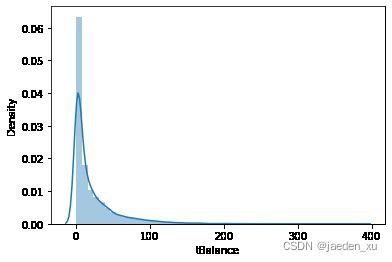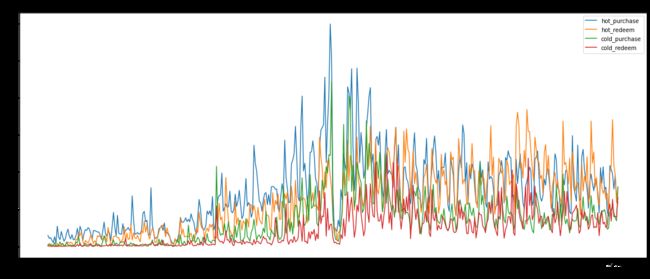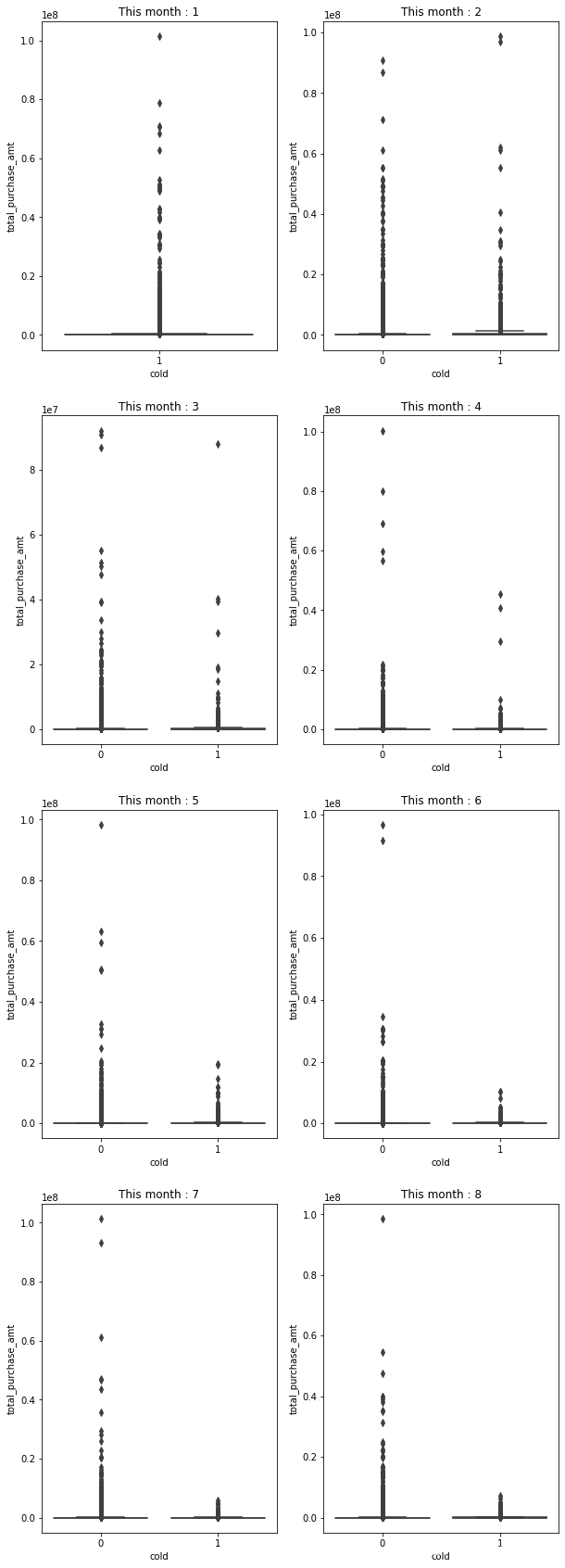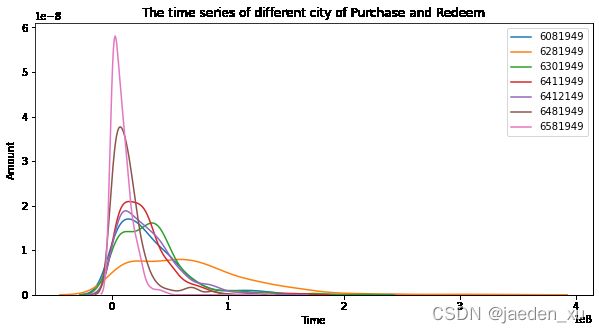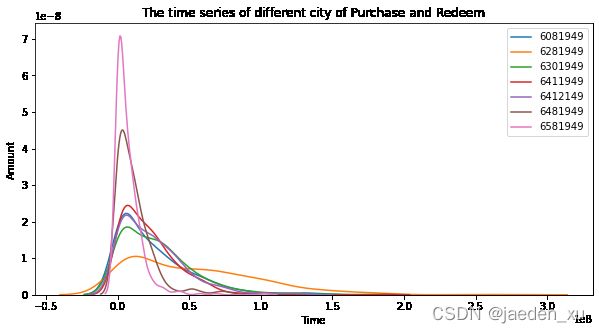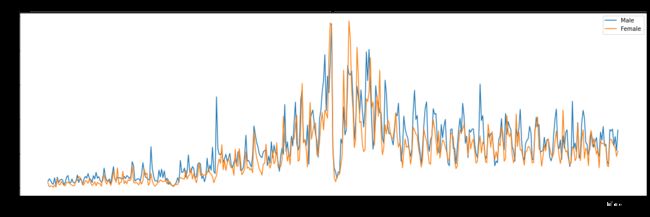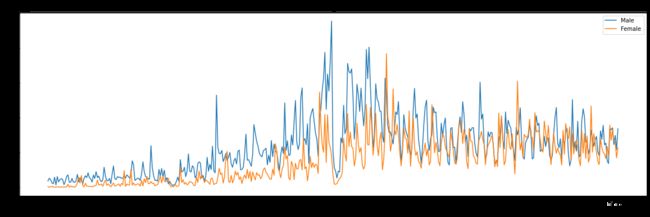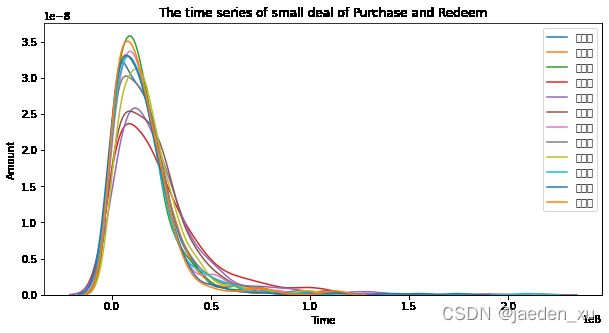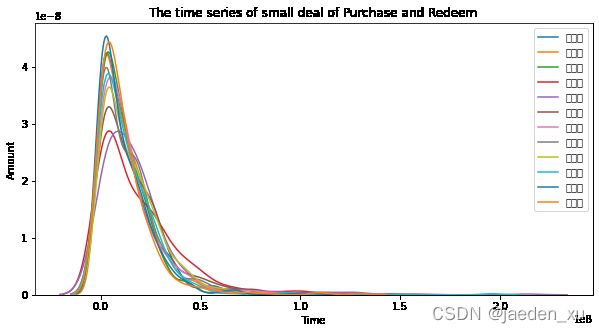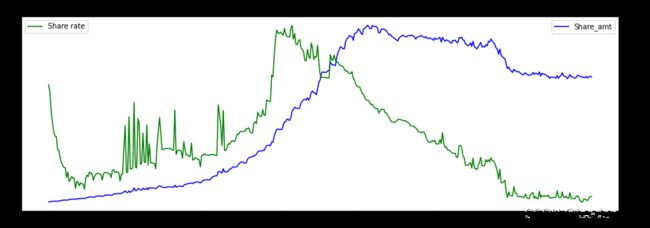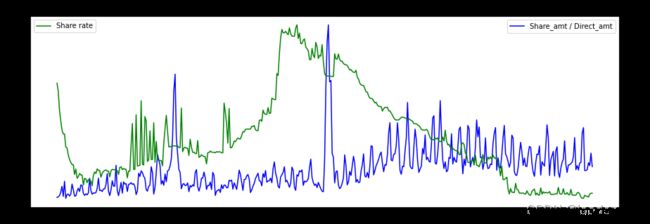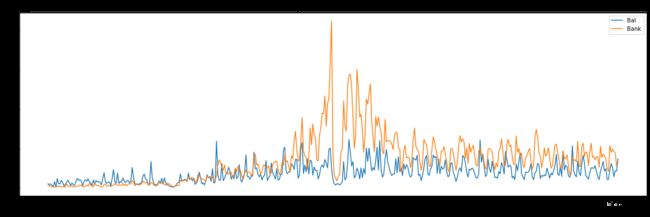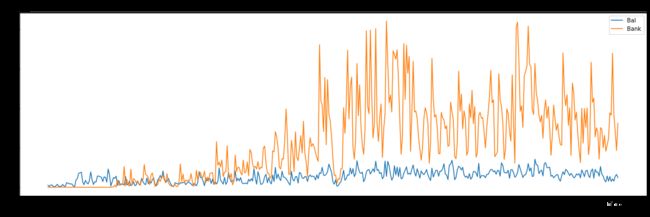【算法竞赛学习】资金流入流出预测-挑战Baseline_数据探索与分析2
赛题简介
蚂蚁金服拥有上亿会员并且业务场景中每天都涉及大量的资金流入和流出,面对如此庞大的用户群,资金管理压力会非常大。在既保证资金流动性风险最小,又满足日常业务运转的情况下,精准地预测资金的流入流出情况变得尤为重要。此届大赛以《资金流入流出预测》为题,期望参赛者能够通过对例如余额宝用户的申购赎回数据的把握,精准预测未来每日的资金流入流出情况。对货币基金而言,资金流入意味着申购行为,资金流出为赎回行为 。
赛题与数据
竞赛中使用的数据主要包含四个部分,分别为用户基本信息数据、用户申购赎回数据、收益率表和银行间拆借利率表。https://tianchi.aliyun.com/competition/entrance/231573/information
数据探索与分析2
import pandas as pd
import numpy as np
import warnings
import datetime
import seaborn as sns
import matplotlib.pyplot as plt
from scipy import stats
warnings.filterwarnings('ignore')
# Load the balance data
data_balance = pd.read_csv('Data/user_balance_table.csv')
# add tiemstamp to dataset
data_balance['date'] = pd.to_datetime(data_balance['report_date'], format= "%Y%m%d")
data_balance['day'] = data_balance['date'].dt.day
data_balance['month'] = data_balance['date'].dt.month
data_balance['year'] = data_balance['date'].dt.year
data_balance['week'] = data_balance['date'].dt.week
data_balance['weekday'] = data_balance['date'].dt.weekday
# total amount
total_balance = data_balance.groupby(['date'])['total_purchase_amt','total_redeem_amt'].sum()
total_balance.reset_index(inplace=True)
# Add time stamp
total_balance['day'] = total_balance['date'].dt.day
total_balance['month'] = total_balance['date'].dt.month
total_balance['year'] = total_balance['date'].dt.year
total_balance['week'] = total_balance['date'].dt.week
total_balance['weekday'] = total_balance['date'].dt.weekday
# Load user's information
users = pd.read_csv('Data/user_profile_table.csv')
分析大小额用户
前面的分析可以看出,某些用户的交易额很大,对于日交易量很明显,这里统计四月份后依旧活跃的大额用户(大于100万)
# 获得大额用户的集合
temp = data_balance[(data_balance['total_purchase_amt'] >= 1000000) | (data_balance['total_redeem_amt'] >= 1000000)]
big_users_set = set(temp[temp['date'] >= datetime.datetime(2014,4,1)]['user_id'])
len(big_users_set)
max(data_balance['user_id'])
# 标记大额用户
data_balance['big_user'] = 0
data_balance.loc[data_balance['user_id'].isin(big_users_set), 'big_user'] = 1
# 统计大额用户与小额用户的日总交易额的区别
total_balance_bigNsmall = data_balance.groupby(['date','big_user'], as_index=False)['total_purchase_amt','total_redeem_amt'].sum()
# 画出大额用户与小额用户交易的日总交易量图
fig = plt.figure(figsize=(20,8))
plt.plot(total_balance_bigNsmall[total_balance_bigNsmall['big_user'] == 1]['date'], total_balance_bigNsmall[total_balance_bigNsmall['big_user'] == 1]['total_purchase_amt'],label='big_purchase')
plt.plot(total_balance_bigNsmall[total_balance_bigNsmall['big_user'] == 1]['date'], total_balance_bigNsmall[total_balance_bigNsmall['big_user'] == 1]['total_redeem_amt'],label='big_redeem')
plt.plot(total_balance_bigNsmall[total_balance_bigNsmall['big_user'] == 0]['date'], total_balance_bigNsmall[total_balance_bigNsmall['big_user'] == 0]['total_purchase_amt'],label='small_purchase')
plt.plot(total_balance_bigNsmall[total_balance_bigNsmall['big_user'] == 0]['date'], total_balance_bigNsmall[total_balance_bigNsmall['big_user'] == 0]['total_redeem_amt'],label='small_redeem')
plt.legend(loc='best')
plt.title("The time series of big and small user of Purchase and Redeem")
plt.xlabel("Time")
plt.ylabel("Amount")
plt.show()
# 统计大额小额用户购买量占比
np.sum(total_balance_bigNsmall[total_balance_bigNsmall['big_user'] == 1]['total_purchase_amt']) / np.sum(total_balance_bigNsmall[total_balance_bigNsmall['big_user'] == 0]['total_purchase_amt'])
# 统计大额小额用户赎回量占比
np.sum(total_balance_bigNsmall[total_balance_bigNsmall['big_user'] == 1]['total_redeem_amt']) / np.sum(total_balance_bigNsmall[total_balance_bigNsmall['big_user'] == 0]['total_redeem_amt'])
分析用户的交易频次
# 画出非0交易的分布图
frequency = data_balance[(data_balance['direct_purchase_amt'] != 0) | (data_balance['total_redeem_amt'] != 0)][['user_id','tBalance']].groupby('user_id', as_index=False).count()
sns.distplot(frequency['tBalance'])
# 获取频繁交易用户集合
hot_users_set = set(frequency[frequency['tBalance'] > 30]['user_id'])
# 获取频繁用户的交易纪录
data_balance['is_hot_users'] = 0
data_balance.loc[data_balance['user_id'].isin(hot_users_set) , 'is_hot_users'] = 1
# 统计频繁用户与非频繁用户的日总交易额的区别
total_balance_hotNcold = data_balance.groupby(['date','is_hot_users'], as_index=False)['total_purchase_amt','total_redeem_amt'].sum()
# 绘制频繁用户与非频繁用户总购买赎回量的时序图
fig = plt.figure(figsize=(20,8))
plt.plot(total_balance_hotNcold[total_balance_hotNcold['is_hot_users'] == 1]['date'], total_balance_hotNcold[total_balance_hotNcold['is_hot_users'] == 1]['total_purchase_amt'],label='hot_purchase')
plt.plot(total_balance_hotNcold[total_balance_hotNcold['is_hot_users'] == 1]['date'], total_balance_hotNcold[total_balance_hotNcold['is_hot_users'] == 1]['total_redeem_amt'],label='hot_redeem')
plt.plot(total_balance_hotNcold[total_balance_hotNcold['is_hot_users'] == 0]['date'], total_balance_hotNcold[total_balance_hotNcold['is_hot_users'] == 0]['total_purchase_amt'],label='cold_purchase')
plt.plot(total_balance_hotNcold[total_balance_hotNcold['is_hot_users'] == 0]['date'], total_balance_hotNcold[total_balance_hotNcold['is_hot_users'] == 0]['total_redeem_amt'],label='cold_redeem')
plt.legend(loc='best')
plt.title("The time series of big and small user of Purchase and Redeem")
plt.xlabel("Time")
plt.ylabel("Amount")
plt.show()
# 画出冷启动用户与老用户交易的箱型图
temp = data_balance[['year','month','user_id','total_purchase_amt','total_redeem_amt']].groupby(['year','month','user_id'], as_index=False).sum()
user_old_set = set()
plt.figure(figsize=(10,30))
for i in range(1, 9):
newset = set(temp[(temp['year'] == 2014) & (temp['month'] == i)]['user_id'])
this_month = data_balance[(data_balance['year'] == 2014) & (data_balance['month'] == i)]
this_month['cold'] = 0
this_month.loc[this_month['user_id'].isin(newset - user_old_set), 'cold'] = 1
plt.subplot(4,2,i)
plt.title('This month : ' + str(i))
sns.boxplot(x="cold", y="total_purchase_amt" , data=this_month[(this_month['direct_purchase_amt'] != 0) | (this_month['total_redeem_amt'] != 0)])
user_old_set = user_old_set | newset
plt.show()
分析用户的其他属性
# 用户的其他属性
users.head()
# 添加城市、星座、性别
data_balance = pd.merge(data_balance, users, on='user_id')
# 统计每个城市用户的日总交易额的区别并绘制分布估计图
fig = plt.figure(figsize=(10,5))
for i in np.unique(data_balance['city']):
temp = data_balance.groupby(['date','city'], as_index=False)['total_purchase_amt','total_redeem_amt'].sum()
ax = sns.kdeplot( temp[temp['city'] == i]['total_purchase_amt'],label=i)
plt.legend(loc='best')
plt.title("The time series of different city of Purchase and Redeem")
plt.xlabel("Time")
plt.ylabel("Amount")
plt.show()
fig = plt.figure(figsize=(10,5))
for i in np.unique(data_balance['city']):
temp = data_balance.groupby(['date','city'], as_index=False)['total_purchase_amt','total_redeem_amt'].sum()
ax = sns.kdeplot( temp[temp['city'] == i]['total_redeem_amt'],label=i)
plt.legend(loc='best')
plt.title("The time series of different city of Purchase and Redeem")
plt.xlabel("Time")
plt.ylabel("Amount")
plt.show()
# 统计每个性别用户的日总交易额的区别,并绘制时序图
temp = data_balance.groupby(['date','sex'], as_index=False)['total_purchase_amt','total_redeem_amt'].sum()
fig = plt.figure(figsize=(20,6))
plt.plot(temp[temp['sex'] == 1]['date'], temp[temp['sex'] == 1]['total_purchase_amt'],label='Male')
plt.plot(temp[temp['sex'] == 0]['date'], temp[temp['sex'] == 0]['total_purchase_amt'],label='Female')
plt.legend(loc='best')
plt.title("The time series of two gender user of Purchase")
plt.xlabel("Time")
plt.ylabel("Amount")
plt.show()
fig = plt.figure(figsize=(20,6))
plt.plot(temp[temp['sex'] == 1]['date'], temp[temp['sex'] == 1]['total_purchase_amt'],label='Male')
plt.plot(temp[temp['sex'] == 0]['date'], temp[temp['sex'] == 0]['total_redeem_amt'],label='Female')
plt.legend(loc='best')
plt.title("The time series of two gender user of Redeem")
plt.xlabel("Time")
plt.ylabel("Amount")
plt.show()
# 统计每个星座用户的日总交易额的区别 并绘制分布估计图
fig = plt.figure(figsize=(10,5))
for i in np.unique(data_balance['constellation']):
temp = data_balance.groupby(['date','constellation'], as_index=False)['total_purchase_amt','total_redeem_amt'].sum()
ax = sns.kdeplot( temp[temp['constellation'] == i]['total_purchase_amt'],label=i)
plt.legend(loc='best')
plt.title("The time series of small deal of Purchase and Redeem")
plt.xlabel("Time")
plt.ylabel("Amount")
plt.show()
fig = plt.figure(figsize=(10,5))
for i in np.unique(data_balance['constellation']):
temp = data_balance.groupby(['date','constellation'], as_index=False)['total_purchase_amt','total_redeem_amt'].sum()
ax = sns.kdeplot( temp[temp['constellation'] == i]['total_redeem_amt'],label=i)
plt.legend(loc='best')
plt.title("The time series of small deal of Purchase and Redeem")
plt.xlabel("Time")
plt.ylabel("Amount")
plt.show()
其他分析
# 统计每个性别用户的日总交易额的区别
temp = data_balance.groupby(['date'], as_index=False)['direct_purchase_amt','share_amt'].sum()
# 画出每日利息的增长/直接购买量的时序图
fig = plt.figure(figsize=(20,6))
plt.plot(temp['date'], temp['share_amt'] / temp['direct_purchase_amt'] ,label='Rate')
plt.legend(loc='best')
plt.title("The rate of Share / Purchase")
plt.xlabel("Time")
plt.ylabel("Amount")
plt.show()
# 加载支付宝利率数据
share = pd.read_csv('Data/mfd_day_share_interest.csv')
share = share.rename(columns = {'mfd_date': 'date'})
share_features = [x for x in share.columns if x not in ['date']]
share['date'] = pd.to_datetime(share['date'], format= "%Y%m%d")
share['day'] = share['date'].dt.day
share['month'] = share['date'].dt.month
share['year'] = share['date'].dt.year
share['week'] = share['date'].dt.week
share['weekday'] = share['date'].dt.weekday
# 绘制支付宝利率与交易额的时序图
fig,ax1 = plt.subplots(figsize=(15,5))
plt.plot(temp['date'], temp['share_amt'],'b',label="Share_amt")
plt.legend()
ax2=ax1.twinx()
plt.plot(share['date'], share['mfd_daily_yield'],'g',label="Share rate")
plt.legend(loc=2)
plt.title("The correlation between share rate and share amount")
plt.xlabel("Time")
plt.ylabel("Rate & Amount")
plt.show()
# 支付宝利率与每日利息的增长/直接购买量的时序图
fig,ax1 = plt.subplots(figsize=(15,5))
plt.plot(temp['date'], temp['share_amt'] / temp['direct_purchase_amt'],'b',label="Share_amt / Direct_amt")
plt.legend()
ax2=ax1.twinx()
plt.plot(share['date'], share['mfd_daily_yield'],'g',label="Share rate")
plt.legend(loc=2)
plt.title("The correlation between share rate and Share/Purchase")
plt.xlabel("Time")
plt.ylabel("Rate & Amount")
plt.show()
# 聚合两种不同购买方式
temp = data_balance.groupby(['date'], as_index=False)['purchase_bal_amt','purchase_bank_amt'].sum()
# 画出不同购买方式日购买量的时序图
fig = plt.figure(figsize=(20,6))
plt.plot(temp['date'], temp['purchase_bal_amt'],label='Bal')
plt.plot(temp['date'], temp['purchase_bank_amt'],label='Bank')
plt.legend(loc='best')
plt.title("The purchase of bal and bank")
plt.xlabel("Time")
plt.ylabel("Amount")
plt.show()
# 画出不同赎回方式日赎回量的时序图
temp = data_balance.groupby(['date'], as_index=False)['tftobal_amt','tftocard_amt'].sum()
fig = plt.figure(figsize=(20,6))
plt.plot(temp['date'], temp['tftobal_amt'],label='Bal')
plt.plot(temp['date'], temp['tftocard_amt'],label='Bank')
plt.legend(loc='best')
plt.title("The redeem of bal and bank")
plt.xlabel("Time")
plt.ylabel("Amount")
plt.show()

